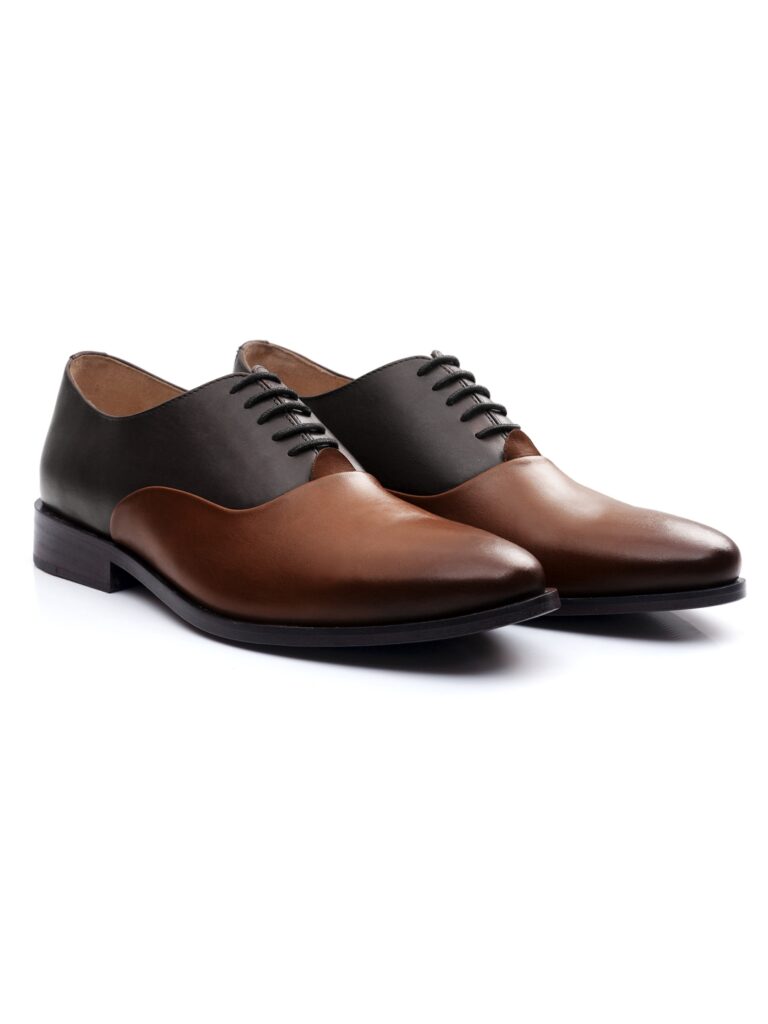Footwear was made of various quality leather. Thick, dense cowhide leather was used for the simplest shoes, without any decoration, worn by artisans and peasants.
In the Novgorod cultural layer of the 11th-13th centuries, symmetrical shoes for both left and right feet were found with narrow heels [pjatka]. Shoes with stamped patterns, such as parallel lines, curls or vegetative designs, also have been discovered in these finds.
Shoe Craftsmanship
During excavations of medieval villages in the north-eastern part of Russia, archeologists found many pairs of shoes [lapti] with different decorations. The most common were leather stamping and embroidery. These were everyday footwear of the peasantry. They were worn with a tightening lace which encircled the ankle and a sole that was sewn on.
To make one lapti a person needed seven strips of bast, two meters long each. To get such strips from a linden tree, the bark had to be stripped from the whole even surface of the trunk without any defects or rotting along its entire length. Thus the ancient Russians got a figurative expression: to strip like a linden.
Different regions had their own methods of making lapti. The Moscow ones were high on the ankle, while those of the Northern areas were low with pointed toes. Winter lapti were made with double layers of bast.
In the 12th century shoemakers in Novgorod started to decorate their footwear with woolen thread and leather carving. These patterns were various combinations of crosses, zigzags, and triangles.
Leather Shoe Production
The art of shoemaking in medieval Novgorod has received scant attention in literature. This is probably due to the extreme limitedness of the archeological materials that are our main source for studying this subject.
The bulk of the footwear found in Novgorod archaeological sites belongs to the 10th–14th centuries and includes shoes of various kinds. Thick, dense cowhide leather was used for the simplest shoes without any decoration and were intended for broad strata of the population (artisans and peasants). Softer and thinner leather was used for openwork embroidered footwear.
Stamped designs on the surface of the leather were made using embroidery or leather carving techniques. They included rows of parallel or crossing lines, curls, and vegetative designs. The most popular design on openwork footwear was a pair of stylized flowers.
Besides the flowers, the footwear was decorated with other ornaments – a pair of eyes, a bow and string, and so on. The feet were protected with a pair of thick soles that were sewn to the shoe.
According to the INE statistics, manufacturing output in Russia was up in May 2022 as compared with the same month last year. Leather and footwear was among the industries that boosted output. The growth was largely driven by the demand for safety giay luoi nam cao cap footwear. The Russian company Vostok-Service>> produces safety footwear at its own production sites – Torzhok Shoe Factory>> ZAO (Torzhok, Tver region) and Working Style>> OOO (Uzlovaya, Tula region). The company is also an authorized distributor of the German brand Desma.

Traditional Techniques
By the 12th century, shoemaking was well established in Novgorod. Shoes of various types were found in layers of this period, including bog shoes (lapti), soft shoes, ankle boots, and shoes with high sides that reached the ankle (porshni). All these were woven from birch, linden, oak, or elm bark; bast was then stripped from the bark and cut into strips for weaving.
Depending on how the pieces of leather were positioned face to face or abutting one another, they were joined using either saddle stitches or hidden stitches. When the upper leather piece abutted the lower leather piece, it was sewn to it with a butt seam [Rus. tachnyi shov, tachnyj shov].
Another form of winter footwear was burki (feather and felt boots) sewn from white felt. These were worn by the upper classes and were a distinguishing feature of the top Party leaders, generals, government officials, and military commanders.
The 14th century saw the decline of simple and openwork shoes in favor of knee-high boots, which were characterized by narrow heel sections, small openings for threading laces, and holes or cuts in the bootlegs for decorative leather straps. These are the kinds of shoes that have been found in the cultural layer of Novgorod, and a leather lace was used to tighten them at the ankle.
Modern Innovation
VV: I think the sneaker culture in Russia is still pretty young. But I believe it’s developing progressively – and the market is getting bigger by the day. It’s not like it was in the 1990s when sneakers were limited to a small number of Moscow and Saint Petersburg residents who could afford foreign brands.
Nowadays, the Russian footwear industry tries to take on modern trends and technologies by incorporating them into its own production processes. For instance, Obuv Rossii developed an automated system for manufacturing clogs and flip-flops using EVA on solid technology. The system is one of the most advanced in its field.
Shoemakers are also experimenting with the use of new materials. In addition, they are implementing the latest IT solutions to improve omnichannel trade and increase customer loyalty by offering a set of additional services.
For instance, in the near future the company plans to develop and introduce new lines of footwear for children and women. It will be possible to buy shoes with a matching bag, shoe care products and hosiery. All of these additions will help to boost sales, encourage complex purchases and strengthen customer loyalty.